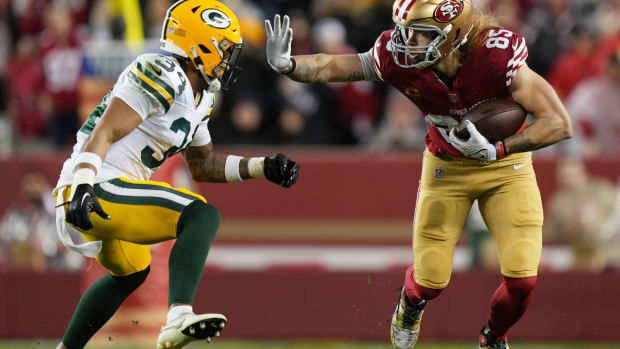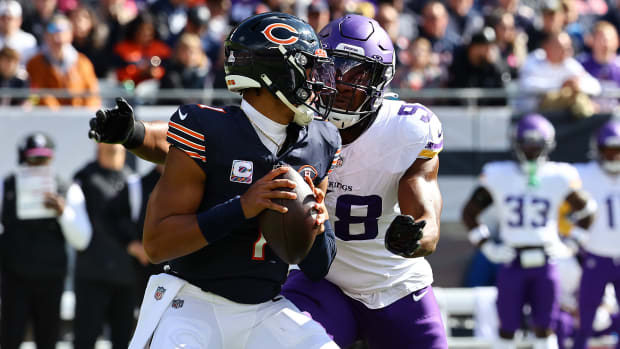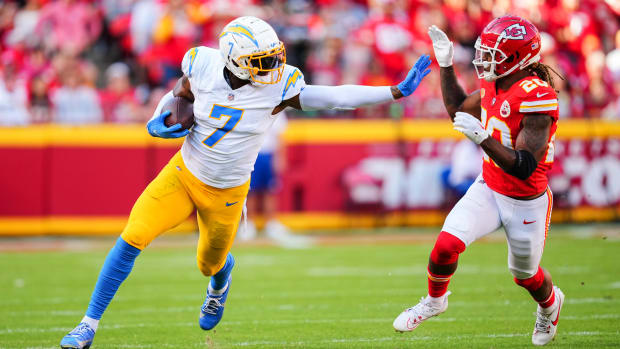A Bears Option If They Lose Allen Robinson
If the Bears decided to tag wide receiver Allen Robinson and then trade him, it would make more sense than simply letting him leave.
Most Bears fans would cry out how none of it makes sense and he needs a new contract.
Many of the same people would screaming how they also need a new veteran quarterback starting next year. Accomplishing all of this might not be possible due to salary cap constraints, especially this year due to the pandemic.
So what would become of the Bears on offense if they actually dealt Robinson in a tag-and-trade?
The franchise wouldn't fold.
They couldn't be expected to count on Anthony Miller, Darnell Mooney, Riley Ridley and Javon Wims at receiver. There isn't a proven receiver in the group, although Mooney's rookie year should generate excitement.
While it's not certain the exact direction they would go in terms of players, they most likely would follow the Kansas City route again.
Matt Nagy has faith in the Chiefs system and it doesn't necessarily include a dominant, contested-catch big "X" receiver in the mold of Robinson.
The closest thing the Chiefs have to this type of player is starting X-receiver Sammy Watkins, who is 6-foot-1, and also Demarcus Robinson, who is the same height. Robinson was targeted only a career-high 59 times last season and is just an extra, like Wims or Ridley.
Watkins has been the starter there but is not the same type of receiver as Allen Robinson at all.
Kansas City's offense works for big-time yards per attempt both because they have Patrick Mahomes and also because they have the fastest overall group of receivers in the league. They get yards after the catch and they get downfield.
Watkins ran 4.3 in the 40-yard dash at the combine before being drafted by Buffalo. He's a field stretcher.
Robinson is not a field stretcher in the same sense, although he can come up with big gains downfield. He's capable of catching passes 30 yards downfield with a big vertical leap, a back shoulder throw or a contested catch of some kind. Watkins' speed makes him a touchdown threat every play, not just a 25- or 30-yard threat.
Robinson last year finished 47th in the league in yards after the catch, his best season with the Bears in this respect. He had 319 yards after the catch per Sportradar via Profootballreference.com.
Robinson's average of 3.1 yards after each reception ranked 137th in the NFL. Tight end Jimmy Graham ranked 112th and averaged 4.0 yards after each catch, at age 34. Robinson was ranked 146th at this statistic in 2019 (2.8) and 100th (3.9) in 2018, the year after his torn ACL.
This shouldn't be construed as a slam at Robinson but more an illustration of how effective he is at his style of ball, at making catches in cramped quarters, whether with a defender draped on his back, along the sidelines or both. It can work but isn't as conducive to what Nagy likes to see in his offense.
Nagy wants yards after the catch, more big gainers and long touchdowns. He wants to put real pressure on defenses downfield, then get the yards after the catch underneath when defenses overprotect against the big gain.
This isn't to suggest the Bears can't make it work with Robinson. In that case, it's always going to require more long drives and fewer big plays downfield.
What Robinson does is remarkable in terms of contested catches, but there is a huge difference between first downs and touchdowns.
Watkins is nowhere near the sure-handed receiving threat Robinson is but his speed can scare off coverage and it also opens up underneath routes for other receivers.
What the Chiefs do is pair him with two more ridiculously fast receivers, Z-receiver Tyreek Hill and slot Mecole Hardman. Hill is a sub-4.3 guy and Hardman ran 4.33.
Robinson ran 4.6 and none of the Bears receivers except Mooney ran below 4.5. He was in the mold of Chiefs receivers at 4.38.
What the Bears would do without Robinson is try to get faster at wide receiver, whether it would be through the draft, a trade or even free agency. It would be different, but more in line with what Nagy sought when he came to Chicago.
Coincidentally, Watkins is an unrestricted free agent who played on a one-year, $9 million deal last season. That's about $11 million less than what has been reported as an annual average salary sought by Allen Robinson. Some reports have suggested Robinson sought more than $20 million annually.
Watkins is the same age as Robinson and Spotrac.com projects his average annual salary for a 2021 contract to be "only" $10.6 million.
It's not a suggestion as much as it is pointing out one of several potential paths.
Twitter: BearDigest@BearsOnMaven




